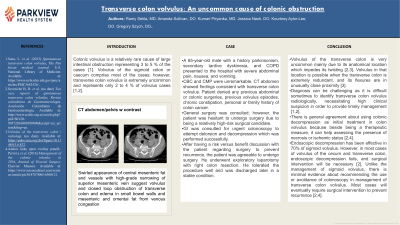Monday Poster Session
Category: Colon
P1711 - Transverse Colon Volvulus: An Uncommon Cause of Colonic Obstruction
Monday, October 23, 2023
10:30 AM - 4:15 PM PT
Location: Exhibit Hall

Has Audio

Kumari Piryanka, MD
Parkview Medical Center
Pueblo, Colorado
Presenting Author(s)
Ramy Sekla, MD, Amanda Sullivan, DO, Kumari Piryanka, MD, Jessica Nash, DO, Kourtney Aylor-Lee, DO, Gregory Szych, DO
Parkview Medical Center, Pueblo, CO
Introduction: Colonic volvulus is a relatively rare cause of large intestinal obstruction representing 3 to 5 % of the cases. Volvulus of the sigmoid colon or caecum comprise most of the cases; however, transverse colon volvulus is extremely uncommon and represents only 2 to 4 % of volvulus cases.
Case Description/Methods: A 65-year-old male with a history parkinsonism, secondary tardive dyskinesia, and COPD presented to the hospital with severe abdominal pain, nausea, and vomiting. He was hemodynamically stable on presentation. CBC and CMP were unremarkable. CT abdomen showed findings consistent with transverse colon volvulus. Patient denied any previous abdominal or colonic surgeries, previous volvulus episodes, chronic constipation, personal or family history of colon cancer. General surgery was consulted; however, the patient was hesitant to undergo surgery due to being a relatively high-risk surgical candidate. GI was consulted for urgent colonoscopy to attempt detorsion and decompression which was performed successfully. After having a risk versus benefit discussion with the patient regarding surgery to prevent recurrence, the patient was agreeable to undergo surgery. He underwent exploratory laparotomy with right colon resection. He tolerated the procedure well and was discharged later in a stable condition.
Discussion: Volvulus of the transverse colon is very uncommon mainly due to its anatomical location which impedes its twisting. Volvulus in that location is possible when the transverse colon is extremely redundant, and its flexures are in unusually close proximity. Diagnosis can be challenging as it is difficult sometimes to identify transverse colon volvulus radiologically, necessitating high clinical suspicion in order to provide timely management.
Management of transverse colon volvulus can be controversial for patients with viable colon and no evidence or peritonitis. There is general agreement about using colonic decompression as initial treatment in colon volvulus because beside being a therapeutic measure, it can help assessing the presence of necrosis or ischemic status. Endoscopic decompression has been effective in 70% of sigmoid volvulus. However, in most cases of volvulus of the cecum and transverse colon, endoscopic decompression fails, and surgical intervention will be necessary. There is minimal evidence about recommending the use or avoidance of colonoscopy in management of transverse colon volvulus. Most cases will eventually require surgical intervention to prevent recurrence.
Disclosures:
Ramy Sekla, MD, Amanda Sullivan, DO, Kumari Piryanka, MD, Jessica Nash, DO, Kourtney Aylor-Lee, DO, Gregory Szych, DO. P1711 - Transverse Colon Volvulus: An Uncommon Cause of Colonic Obstruction, ACG 2023 Annual Scientific Meeting Abstracts. Vancouver, BC, Canada: American College of Gastroenterology.
Parkview Medical Center, Pueblo, CO
Introduction: Colonic volvulus is a relatively rare cause of large intestinal obstruction representing 3 to 5 % of the cases. Volvulus of the sigmoid colon or caecum comprise most of the cases; however, transverse colon volvulus is extremely uncommon and represents only 2 to 4 % of volvulus cases.
Case Description/Methods: A 65-year-old male with a history parkinsonism, secondary tardive dyskinesia, and COPD presented to the hospital with severe abdominal pain, nausea, and vomiting. He was hemodynamically stable on presentation. CBC and CMP were unremarkable. CT abdomen showed findings consistent with transverse colon volvulus. Patient denied any previous abdominal or colonic surgeries, previous volvulus episodes, chronic constipation, personal or family history of colon cancer. General surgery was consulted; however, the patient was hesitant to undergo surgery due to being a relatively high-risk surgical candidate. GI was consulted for urgent colonoscopy to attempt detorsion and decompression which was performed successfully. After having a risk versus benefit discussion with the patient regarding surgery to prevent recurrence, the patient was agreeable to undergo surgery. He underwent exploratory laparotomy with right colon resection. He tolerated the procedure well and was discharged later in a stable condition.
Discussion: Volvulus of the transverse colon is very uncommon mainly due to its anatomical location which impedes its twisting. Volvulus in that location is possible when the transverse colon is extremely redundant, and its flexures are in unusually close proximity. Diagnosis can be challenging as it is difficult sometimes to identify transverse colon volvulus radiologically, necessitating high clinical suspicion in order to provide timely management.
Management of transverse colon volvulus can be controversial for patients with viable colon and no evidence or peritonitis. There is general agreement about using colonic decompression as initial treatment in colon volvulus because beside being a therapeutic measure, it can help assessing the presence of necrosis or ischemic status. Endoscopic decompression has been effective in 70% of sigmoid volvulus. However, in most cases of volvulus of the cecum and transverse colon, endoscopic decompression fails, and surgical intervention will be necessary. There is minimal evidence about recommending the use or avoidance of colonoscopy in management of transverse colon volvulus. Most cases will eventually require surgical intervention to prevent recurrence.
Disclosures:
Ramy Sekla indicated no relevant financial relationships.
Amanda Sullivan indicated no relevant financial relationships.
Kumari Piryanka indicated no relevant financial relationships.
Jessica Nash indicated no relevant financial relationships.
Kourtney Aylor-Lee indicated no relevant financial relationships.
Gregory Szych indicated no relevant financial relationships.
Ramy Sekla, MD, Amanda Sullivan, DO, Kumari Piryanka, MD, Jessica Nash, DO, Kourtney Aylor-Lee, DO, Gregory Szych, DO. P1711 - Transverse Colon Volvulus: An Uncommon Cause of Colonic Obstruction, ACG 2023 Annual Scientific Meeting Abstracts. Vancouver, BC, Canada: American College of Gastroenterology.
